
Wool Carpet making and Eagle Training by Lake Issyk-Kul, Kyrgyzstan
By Annie Chen
GoNOMAD Senior Writer
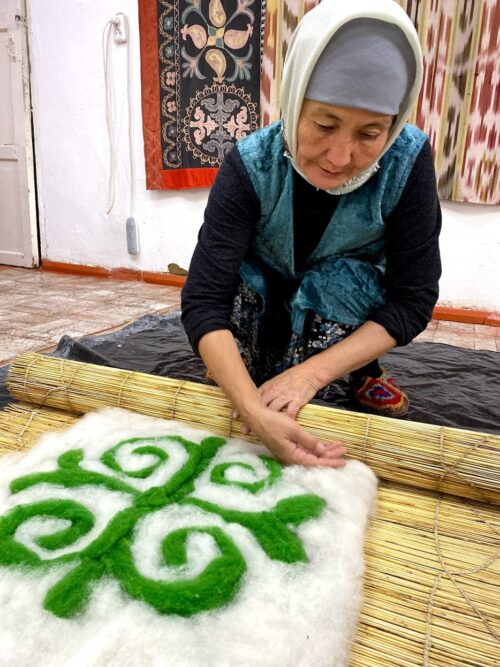
When I got wind that Kyrgyzstan had opened their borders again to tourism after Covid-19 precautions shut down much of the world’s international borders, I jumped at the chance to finally get to explore a bit of Central Asia–and it did not disappoint.
To escape the cosmopolitan buzz of Bishkek, the capital, I headed towards the main bus station where I could grab a ‘marshrutka’, a white, 15-seater van, to Lake Issyk-Kul.
The second-largest salt lake in the world, after the Caspian Sea, it was also a key part of the country’s biosphere and was a former stopping point for travelers on the Silk Road. I’d read that the southern coast held a wealth of activities to do and indescribable landscapes so I set off on my journey.
Wool Workshop
After a 4-hour marshrutka ride that cost 350 com (just over $4 USD), with a short rest stop at the western tip of the diamond-shaped lake, I hopped out in the center of Bokonbaevo, the largest village in the southern coast of the lake.
With a population of 10,000 people, the town’s center was only a few intersecting streets, but I immediately made a beeline for one of the most touted activities in the area- the chance to participate in an authentic and traditional wool workshop.
The Altyn Oimok (“Golden Thimble”) organization was located 3 blocks away, which took less than 10 minutes to walk on well-paved sidewalks and sparse traffic.
A metal gate, slightly ajar, had no signs so I poked my head in and saw a local guide already showing around another tourist. The open courtyard appeared to be someone’s private home, and three separate modest one-story buildings were on different sides of the grassy yard.
After I asked the guide, a young man from a town named Chubak (“Almost like the character in Star Wars!” he enthusiastically grinned), about the workshop, he called through one of the open doorways and out came two older women.
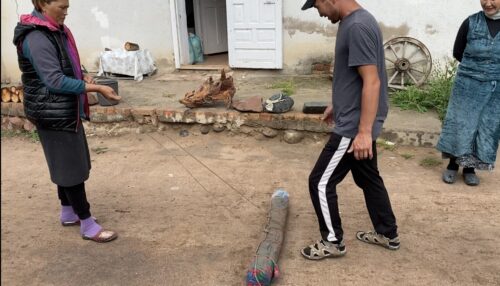
Janya, the main resident, explained in broken English with some assistance from the translator, that this female cooperative came about circa 1995 when the dissolution of the USSR meant a loss of jobs that were previously provided.
The woman realized they’d need to create jobs for themselves, and got to work, focusing on preserving and continuing the tradition of carpet-making.
Creating our carpet
We hunched down on the floor, the two women on adjacent sides of a large wooden rolling mat with large sacks of different colored wool.
The first step, they explained, was creating the base of our carpet so I pointed towards the sack of brown wool. As Janya pulled some tufts out, the other woman spoke about the dying of different colored wool.
For example, the brown that I’d chosen received its’ color from onion shell and hazelnuts boiled together with the cleaned, sheared wool. The tufts of wool were placed, pulled and pressed together in small sections, all facing the same direction and smoothed down to create a square about one square meter.
The second layer would require going in a different direction, leading to a perpendicular layer with a different color (cream). The third and final layer, for a small decorative carpet such as the one we were making, would be the design. Janya chose the traditional design of the curved mountain goat horns, symbolic of wealth since they were the most prized and sought after animal in the region.
As I helped her pull and stretch the green wool to create the horns, layering around it with stark white wool to highlight the green design, Janya proudly continued on about her work as a keeper of the traditions for their relatively new country with traditions dating back centuries.
Children in the U.S.
Her children, two sons, and one daughter had studied in the U.S. where they had secured an invitation for Janya to present at an international artisan crafts fair in Santa Fe, New Mexico one year. She ended up winning a prize, and her craft was acknowledged by UNESCO as an invaluable art, an honor that clearly meant a lot to her.
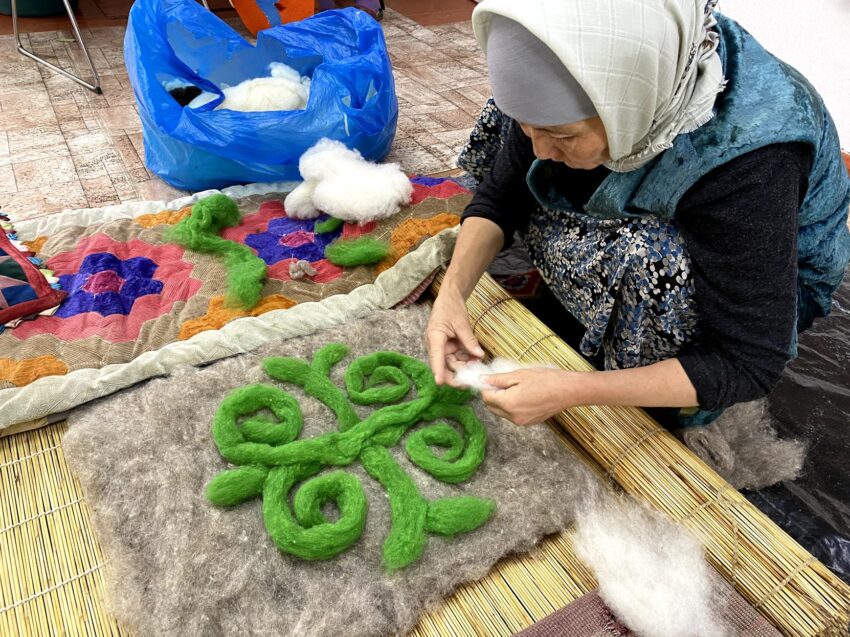
Fusing the fibers
A third woman then came in, motioning for us to move aside, as she maneuvered a pot of boiling water over the wooden mat. Simultaneously, Janya began to roll the wool pattern inside the mat and the third woman slowly poured the boiling hot water over the wool.
The hot water fused the fibers together, and when I asked if Janya didn’t need gloves to deal with the mat and boiling hot water, the women laughed. After all, they had spent years doing this and were well-used to process.
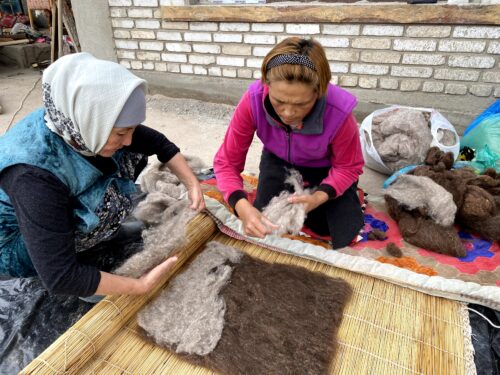
The last step was to tie the rolled-up bundle in a string, and the ladies led me outside to the dirt patch in the center of the courtyard.
One took the end of the string, and Janya moved to refill the pot with more boiling water. The third woman began to kick and stomp on the rolled mat across the yard, the first woman helping to reposition it when the mat moved out of place.
I joined in after a few bewildered kicks as the translator directed me to use more force.
Part of the flattening process required stronger impacts, although nowadays, there is more modern machinery which uses repeated motions to beat the rolled mat.
The traditional method always used pure bodily force anywhere from 45 minutes to 2 hours, depending on the size of the carpet.
Pouring Hot Water on the Mat
The mat grew progressively covered in dirt, and periodically, Janya would pause the women to pour more hot water over the mat.
After 30 minutes of watching them change directions and retighten the strings harnessing the mat, I followed the women over to a grassy area where the string was pulled off and the mat slowly shook out.
It had shrunk considerably and the design had solidified. Even Janya commented that occasionally the pattern outline would bleed unintentionally but ours had turned out solidly.
While the other women cleaned off the wooden mat, Janya flattened out the wool carpet on the ground and began scrubbing at it with a bar of soap. She alternated between lathering up some suds and rinsing it off with some cool water from a bucket- the excess dirt and any other particles would be cleaned in this step.
Finally, she hand-rolled the carpet another 20 times or so, using her arms to roll it in alternating directions. She held up the completed piece and told me to let it dry naturally. In a few hours’ time, it’d be the perfect wall decor or cushion for anyone sitting on the ground of a yurt.
Eagle-training
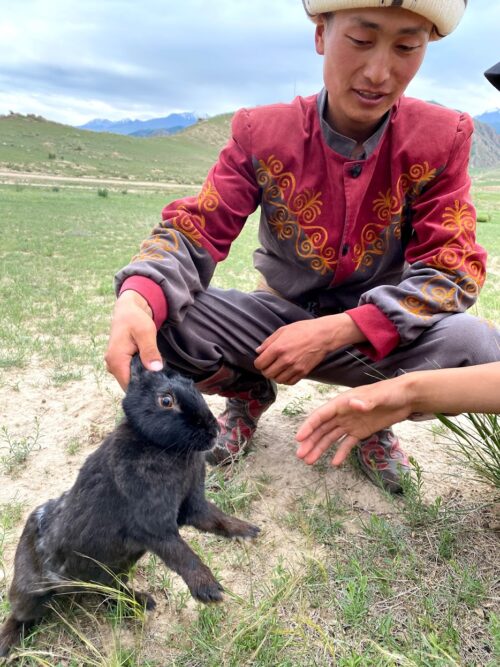
The eagle hunting tradition in Kyrgyzstan was a top priority for me, and I’d read that in the south shore of the lake was where the hunters lived and trained still.
With the help of the CBT (Community-Based Tourism) information office in the heart of Bokonbaevo, I met up with two eagle hunters in the mountains north of town, alongside two French tourists.
The two eagle trainers were clad head-to-toe in traditional Kyrgyz hunting clothing, with red and grey buttoned tops and thick pants tucked into patterned boots.
A thick belt wrapped around the top with a pouch that we later found out had dead pigeon parts in them. Traditional male wool hats called “ak-kalpak”, not uncommon to see in towns either sat on both their heads. Heavy leather gloves protected their right arms from the sharp talons of the eagles.
The two eagles were kept apart, as the trainers explained they were naturally creatures of solitude.
They weigh about 5kg each and they showed us how to feel around in their stomach for how full the creature was after or before a hunt.
The birds were hooded to keep their focus sharp when they were unhooded, and more docile without the ever-present temptation to hunt.
When we took turns donning the glove and holding the eagle, it grew noticeably more agitated and stretched its wings more often. The trainers mentioned that similar to dogs, eagles can tell when the human touching or holding it has experience and confidence around them, or in our case, doesn’t.
As the trainers set up the demonstration, the birds called out, emitting high-pitched screeches, partially out of hunger and partially out of the thrill of being out in the mountains again.
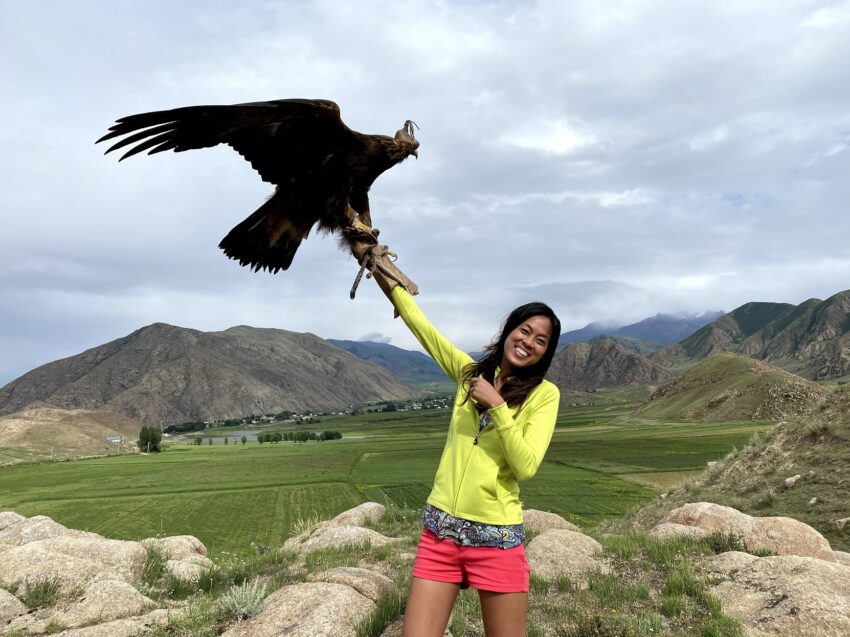
The hunting demonstration
The first trainer and the primary eagle for the demonstration climbed up a nearby mountain to establish the vantage point and height necessary for the hunt. We stood in an open field down below with the second trainer. After they signaled and confirmed that they were both ready, the trainer by us held out his glove and blew a whistle which let out a muted but high sound.
The eagle took off and soared, following the noise as it glided down towards the glove, and perched right on the arm of the trainer. He immediately took out some of the dead pigeon in his pouch and rewarded the eagle, an essential element to any conditioning.

Using a Fox Fur to train the Eagles
The trainer came down to retrieve the eagle and as he climbed up the mountain again to reset for the second demonstration, the other trainer showed us a fox fur that he was going to use. Tied to a long string in the trainer’s hand, the pelt extended from the head all the way to the tip of the tail.
At their signal, the trainer started running with the fur on the string in hand. The eagle soared down from the mountain, eyes trained and locked on to the moving fur, and dove down to crush the fur to the ground in one swift motion. As the trainer went to reward the eagle with more pigeon meat, he pointed out the strong talons suffocating the creature, sometimes up to prey as large as a coyote, and the eagles were trained to wait there with the corpse until the trainers showed up to retrieve it.
The government even pays them sometimes for large carcasses and furs that remain undamaged.
A live prey
The third step, and the reason my vegetarian friend refused to join our outing, was with live prey. The trainers regularly keep rabbits at their home to be used in training sessions and demonstrations, such as the black rabbit that they took out of their car and brought out into the open field.
Incidentally, in the first attempt, the rabbit was so frightened it didn’t move from its place until the last second and the eagle missed it, landing on the ground and shuffling around in the dirt nervously. The trainer went to pick it up, pointing out that without movement, the eagle’s eyes won’t be able to spot camouflaged animals from that high up in the air, even though they can see moving objects up to 3 miles away.

The second trainer came down from the mountain and also clarified that the eagles were too heavy to fly from the ground on their own, and had to launch from a higher point or walk upwards before they could take off again.
The second time, the rabbit started hopping around after a few seconds and the eagle found its prey without any issues, quickly putting an end to the rabbit’s squeal with its talons on the rabbit’s throat.
As its reward, the eagle, with the help of the trainers, plucked away the rabbit fur and ate part of its leg. The trainers pointed out that eagles initially eat every part of the animal, bones, skin, and offal, and later on, will vomit up the parts their bodies don’t digest properly.
The final element of the demonstration was an archery lesson with a bighorn sheep on a target board about 40 meters away.
Hunting with bow and arrow was a traditional part of Kyrgyz nomadic life, and the two trainers demonstrated, with what seemed to be effortless ease, how to peg the center of the board.
As we each took turns, most of our arrows flew above and around the board hitting the dirt. The trainers just smiled patiently as they went to collect our strays in the open field.
Kyrgyzstan in Your Future?
Remember to gather more information to fully prepare for the journey ahead. One thing, in particular, would be securing appropriate travel insurance that will cover adventures like these. Comparing providers like FWD vs MSIG travel insurance can help you find the coverage that best suits your needs, ensuring peace of mind as you explore the rest of Kyrgyzstan’s breathtaking landscapes. Embrace the adventure that awaits and happy trails!
FWD vs MSIG travel insurance would be linked.
- The Interesting Bamileke Region of Cameroon - September 11, 2023
- Mombasa, Kenya: Crocs, Snakes and Empowered Artists - April 9, 2023
- Cameroon’s Douala-Edéa National Park - February 11, 2023

